 Democratic People’s Republic of Korea (Late 2000s-Present)
Democratic People’s Republic of Korea (Late 2000s-Present)
Armored Personnel Carrier – Unknown Number Built
North Korea has, since the 1960s, developed and expanded its military vehicles industry quite considerably. Starting out by locally assembling Soviet vehicles, the country progressively moved onto creating and manufacturing its own vehicles, more and more distinct from original Russian or Chinese inspirations. A key stepstone in this direction was the Cold War-era M1981 light tank, which, while it took inspiration from several Chinese and Soviet designs, was a clear copy or even derivative of none. Though several decades old by this point, a development on the hull of this light tank was first observed by the American Department of Defence in 2009 and given the designation of M2009. Also known as the Chunma-D, this is an armored personnel carrier development of the old light tank – a fairly ironic turn of the affair, as the M1981 itself was based on the chassis of the 323 APC.

Designation
The M2009 designation follows the standard naming scheme of the US Department of Defence for North Korean vehicles, referring to the year in which the vehicle was first observed in service. In North Korea, the vehicle appears to be known as the “Chunma-D” or, in other transliterations, “Junma-Lee”, with the meaning being the same. Chunma/Junma stands for racehorse, with Lee or D is a transliteration of the fourth letter of the Korean alphabet.
Supposed Origins
As pretty much systematic with North Korean vehicles, the development process of the M2009 is a mystery, with awareness of the vehicle coinciding with its appearance in service of the Korean People’s Army during military parades. Nonetheless, one can at least theorize the potential origins of such a vehicle.
The M2009 is a derivative of the M1981 light tank. Though already not state-of-the-art by the late 1970s/early 1980s when it was first introduced, this light tank has become progressively more obsolete over the decades. As the Republic of Korea Army supplemented its M48 Pattons tank with more and more of the K1, outclassing anything fielded by North Korea, the range of targets that could be engaged with hopes of destruction from the M1981’s 85 mm gun decreased accordingly. As such, it has been theorized the M2009 may have been introduced as a way to repurpose the M1981 assembly chain in order to produce a vehicle, in this case an armored personnel carrier, that would remain relevant – at least to an extent, as the M2009 is still far from a reasonably modern vehicle – and be less hopelessly outdated.
General Characteristics


The M2009 is directly based upon the hull of the M1981, and maintains many of its components with little to no apparent changes. This is notably the case of the suspension and engine deck. The hull was originally inspired by the one used in the 323 APC, but lengthened. It uses a six road wheels design, with these road wheels being fairly similar in design to those used on the Soviet PT-76, and generally, Eastern Block amphibious tracked vehicles. The tank uses torsion bars suspension. As for the powerplant, its exact model is unknown, with both 320 and 240 hp engines of various origins having been mentioned. The vehicle notably features a couple of hydrojets, similar in design to the PT-76’s, in order to provide improved amphibious capacities. This feature goes all the way back to the 323, which introduced this to a hull based on the Chinese YW531A that moved on water thanks to the motion of its tracks. The only noticeable changes to the engine deck are the introduction of what appears to be a box – stowage of the Igla anti-air missile has been theorized – and changes to the engine cooling, with a single central grille instead of separate ones. The dimensions of the hull are likely about the same as the M1981, however, the new turret likely changes the height and overall length of the vehicle, and as such only the width can be estimated at about 3.10 m.
Where the vehicle differs from the M1981 is in terms of turret and combat compartment, these having been modified to transform the light tank into an armored personnel carrier. That being said, one may question whether these modifications were enough to create a viable vehicle of this type due to several questionable features.

Combat Compartment
In comparison to the M1981, the M2009 appears to have a slightly heightened combat compartment. This modification was likely introduced to give more space inside for the dismounts. The hull roof, notably, appears to continue to rise slightly upward, with the turret at its highest point, and not be perfectly flat.
The combat and crew compartment of the M2009 are located to the front. The rear engine configuration of the M1981 was retained on the APC, likely due to the additional costs and delays which would be caused by a deeper transformation of the hull. As a result, the infantry compartment appears to be located just under the turret of the M2009. Two firing ports are present on each side of the vehicle, under the turret. Behind these are what appear to be the main point where the dismounts enter and leave the vehicle, a square-shaped side door of fairly diminutive size. The engine compartment is located just behind, suggesting a limited infantry-carrying capacity, likely not exceeding four to six crew members. In front of the turret, hatches for the driver and either another crew member or perhaps a dismount are present.
The infantry accommodations on the M2009 can be described as fairly questionable at best. The vehicle does not feature rear doors, which is already a fairly archaic feature in modern personnel carriers. Rear doors allow for much easier and less risky evacuation of the vehicle, particularly under fire. In comparison, the side doors of the M1981 would typically provide significantly less protection, and exiting the vehicle under fire, in case of an ambush, for example, would be even riskier than on most other APCs. Not only that, but the diminutive size of the doors would also make the evacuation of the vehicle by soldiers in full gear much harder than on a vehicle with large opening rear doors.


The small space allocated for dismounts means the vehicle almost certainly has a lower infantry carrying capacity than the older 323, which also has the advantage of featuring rear doors. In short, in its primary role of carrying infantry, the 2000s Chunma-D proves inferior to the early 1970s 323. The latter has space for ten (according to North Korean sources even twelve) dismounts that can exit the vehicle from the rear, even though the rear door on the 323 has a fairly small size that can already be considered a fairly lackluster feature.
Turret

The other obvious change the M2009 has in comparison to the M1981 is the replacement of the 85 mm armed turret by another design. The M2009 features a cylindrical turret with two 14.5 mm KPV machine guns as main armament, as with the 323. However, the turret is of a different design. Though some inspiration was likely taken from the old APC’s turret, the M2009 ones introduces a variety of new features.
Though conical, the turret of the M2009 is of a wider type. It appears to retain a single crewmember, with a command cupola located to the rear of the turret. A large boxy bustle, likely for stowage, is also present.
Though the main armament of the turret remains the same two 14.5 mm KPV machine guns of the 323 – an armament which was quite heavy for an APC in the early 1970s, but of which the power is now more moderate, as more heavily protected armored personnel carriers tend to become the norm – the design also introduces a coaxial 7.62 mm. While it may seem a little redundant, this may allow for fire on less important and lighter targets to consume less ammunition. Another addition in comparison to the 323 turret is an external infrared searchlight, likely linked to the main armament by braces, as is often the case on North Korean vehicles. Also included are smoke dischargers, three on each side of the turret, a feature that started being observed on M1981s from 2015 onward.
Similar, though not identical turret designs to the M2009 have been observed on the M2010, a series of 8×8 and 6×6 wheeled armored personnel carriers based on the BTR-80 and introduced around the same time in the Korean People’s Army.

North Korean Classic: The Igla

North Korean vehicles, for a long time, but especially in recent years, have very often been observed with man-portable anti-aircraft defense systems (MANPADS) stuck onto the vehicles, from the turret of tanks and APCs to even the fixed superstructure of closed or even open-topped self-propelled artillery pieces. Though some of these have been speculated to be only for show, for example, the large Igla battery present on some 323s during a 1992 parade, some may be functional. It ought to be noted that footage of North Korean armored vehicles in training, outside of parade, often shows the vehicles with the missiles omitted.
The M2009 was first seen without an Igla. However, the vehicle always had some sort of rectangular box just rear of the turret, which has been theorized to actually be storage for the Igla missile launcher. The vehicle quickly appeared with an Igla mounted, as early as 2013 and perhaps even earlier. The missile is fixed to the rear of the turret bustle, which raises questions as to its operation, as it likely is hard to access it from the commander cupola, which is located further forward. A single photo tends to suggest a more forward mount is possible though.


Conclusion – A Questionable Armored Personnel Carrier
The M2009 is, as of today, the most recent tracked armored personnel carrier which has been spotted in the ranks of the KPA. However, it could easily be described as a fairly questionable design.
Though the turret of the vehicle is likely more advanced than the old 323, the vehicle itself appears to be a far worse platform when it comes to carrying infantry. With a dismount compartment located just under the turret, the infantry complement of the vehicle is likely very moderate. With the engine to the rear being retained, the only option to exit the vehicle for the infantry appears to be small side doors – a very inefficient exit means, and one which is likely very dangerous if the vehicle were ever to fall victim to an ambush. Though the numbers of M2009 produced are obviously unknown, the vehicle has little chance of ever coming close to replacing the ubiquitous 323 armored personnel carrier – which is likely for the better. While it may fare better than the 323 if given, for example, purely reconnaissance or infantry support tasks, the M2009 appears far worse as an infantry carrying platform, with the improved combat capacities likely far too little to justify the vehicle’s defects, particularly as South Korean infantry fighting vehicles such as the K21 and the small fleet of BMP-3 provide massively superior combat features.
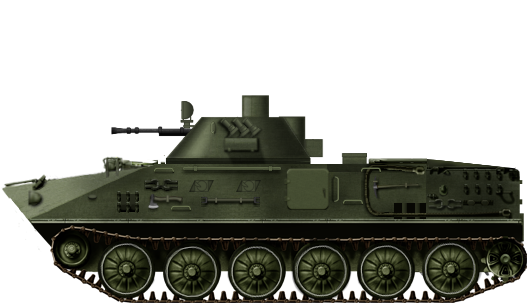
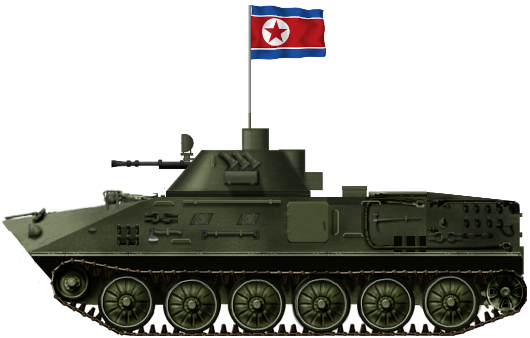
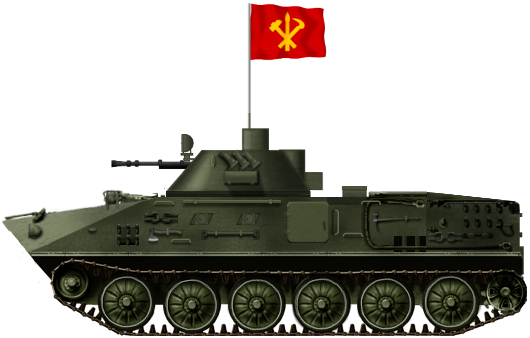
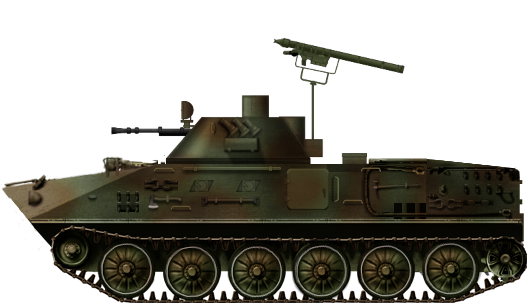
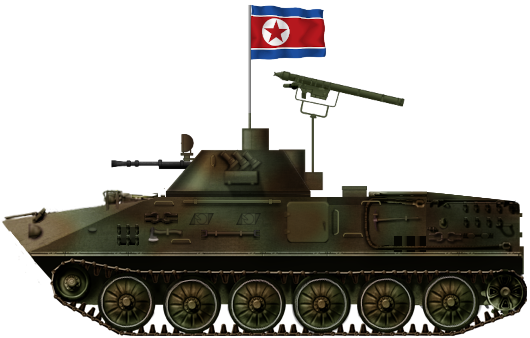
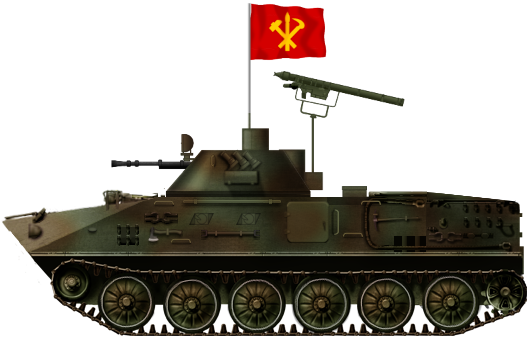
M2009 Chunma-D specifications (estimations) |
|
| Width | 3.10 m (estimation) |
| Weight | Between the 323 (~15 tonnes) and the M1981 (~20 tonnes) |
| Engine | Unknown (Perhaps a 320 hp 8-cylinders air-cooled diesel engine or a 6-cylinders water-cooled 240 hp diesel engine) |
| Suspension | Torsion bars |
| Maximum speed (road) | ~60 km/h (estimation from M1981) |
| Maximum speed (water) | ~10 km/h (estimation from M1981) |
| Range | 500 km (estimation from M1981) |
| Crew | Observation suggests 3 (commander, driver, co-driver), perhaps 2 if co-driver is in fact just a dismount |
| Dismounts | Estimated at 4 to 6 |
| Main Armament | Dual 14.5 mm KPV machine guns |
| Secondary armament | Coaxial 7.62 mm machine gun Igla MANPADS |
| Armor | Most likely 10 to 25 mm (estimation from M1981) |
Sources
THE ARMED FORCES OF NORTH KOREA, On The Path Of Songun, Stijn Mitzer, Joost Oliemans
http://www.massimotessitori.altervista.org/armoursite/nkindigenoustanks/pt-85/chunma-d.htm
Small arms review
Oryx Blog – North Korean vehicles
